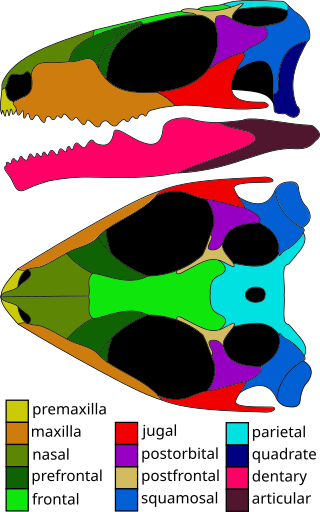
Planocephalosaurus is an extinct genus of basal rhynchocephalian. Fossils of the genus are primarily known from fissure fill deposits from the Late Triassic of southwest Britain, with fragmentary remains possibly belonging to the genus also known from the Late Triassic of Texas.
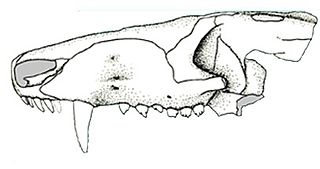
Prozostrodon is an extinct genus of probainognathian cynodonts that was closely related to mammals. The remains were found in Brazil and are dated to the Carnian age of the Late Triassic. The holotype has an estimated skull length of 6.7 centimetres (2.6 in), indicating that the whole animal may have been the size of a cat. The teeth were typical of advanced cynodonts, and the animal was probably a carnivore hunting reptiles and other small prey.
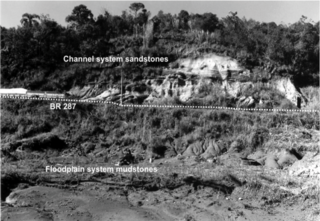
The Santa Maria Formation is a sedimentary rock formation found in Rio Grande do Sul, Brazil. It is primarily Carnian in age, and is notable for its fossils of cynodonts, "rauisuchian" pseudosuchians, and early dinosaurs and other dinosauromorphs, including the herrerasaurid Staurikosaurus, the basal sauropodomorphs Buriolestes and Saturnalia, and the lagerpetid Ixalerpeton. The formation is named after the city of Santa Maria in the central region of Rio Grande do Sul, where outcrops were first studied.

Exaeretodon is an extinct genus of fairly large, low-slung traversodontid cynodonts from the southern parts of Pangea. Four species are known, from various formations. E. argentinus is from the Carnian-age Cancha de Bochas Member of the Ischigualasto Formation in the Ischigualasto-Villa Unión Basin in northwestern Argentina. E. major and E. riograndensis are from the Carnian-age portion of the Santa Maria Formation of the Paraná Basin in southeastern Brazil. E. statisticae is from the Carnian-age Lower Maleri Formation of India.
Proexaeretodon is a genus of traversodontid from the Late Triassic (Carnian) Ischigualasto Formation of Argentina. Although long considered a junior synonym of Exaeretodon, Schmitt et al. revalidated this genus in 2023 based on comparisons with Santagnathus.

The Caturrita Formation is a rock formation found in Rio Grande do Sul, Brazil. Its sediments were deposited in the Paraná Basin. The formation is from the Upper Triassic and forms part of the Santa Maria Supersequence in the upper section of the Rosário do Sul Group.

Clevosaurus is an extinct genus of rhynchocephalian reptile from the Late Triassic and the Early Jurassic periods. Species of Clevosaurus were widespread across Pangaea, and have been found on all continents except Australia and Antarctica. Five species of Clevosaurus have been found in ancient fissure fill deposits in south-west England and Wales, alongside other sphenodontians, early mammals and dinosaurs. In regards to its Pangaean distribution, C. hadroprodon is the oldest record of a sphenodontian from Gondwana, though its affinity to Clevosaurus has been questioned.
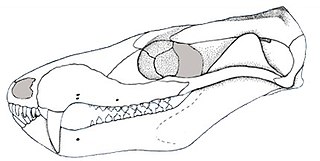
Brasilodon is an extinct genus of small, mammal-like cynodonts that lived in what is now Brazil during the Norian age of the Late Triassic epoch, about 225.42 million years ago. While no complete skeletons have been found, the length of Brasilodon has been estimated at 12 centimetres (4.7 in). Its dentition shows that it was most likely an insectivore. The genus is monotypic, containing only the species B. quadrangularis. Brasilodon belongs to the family Brasilodontidae, whose members were some of the closest relatives of mammals, the only cynodonts alive today. Two other brasilodontid genera, Brasilitherium and Minicynodon, are now considered to be junior synonyms of Brasilodon.
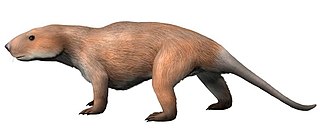
Riograndia is an extinct genus of prozostrodontian cynodonts from the Late Triassic of Brazil. The type and only species is Riograndia guaibensis, named after the State of Rio Grande do Sul and Guaíba Basin, where it was discovered. Remains have been found in the Caturrita Formation of the geopark of Paleorrota. It was a small non-mammalian cynodont, with several advanced features also present in mammals. Several specimens of Riograndia guaibensis have been found in the towns of Candelária and Faxinal do Soturno in the Caturrita Formation. The genus defines the Riograndia Assemblage Zone.

Pachygenelus is an extinct genus of tritheledontid cynodonts. Fossils have been found from the Karoo basin in South Africa and date back to the Early Jurassic.

Irajatherium is an extinct genus of cynodonts, known only of the type species Irajatherium hernandezi. It is named in honor of Irajá Damiani Pinto.
Menadon is an extinct genus of traversodontid cynodonts. The type and only species is Menadon besairiei.
Faxinalipterus is a genus of ornithodiran archosaur, originally described as a pterosaur, from the Late Triassic Caturrita Formation of southern Brazil. A study from 2022 reinterpreted the fossil remains and instead suggests them to belong to a member of the Lagerpetidae, another clade of pterosauromorphs.
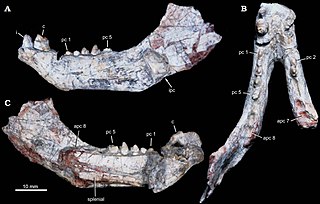
Candelariodon is an extinct genus of carnivorous probainognathian cynodonts from the Middle to Late Triassic Santa Maria Formation of the Paraná Basin in Rio Grande do Sul state, Brazil. Candelariodon is known from a partial mandible having some complete teeth. It was first named by Téo Veiga de Oliveira, Cesar Leandro Schultz, Marina Bento Soares and Carlos Nunes Rodrigues in 2011 and the type species is Candelariodon barberenai.

Clevosaurs are an extinct group of rhynchocephalian reptiles from the Triassic and Jurassic periods.
Fraxinisaura is an extinct genus of basal lepidosauromorph reptile known from the Middle Triassic of Germany. The only known species is Fraxinisaura rozynekae. It possessed an elongated snout, unique features of the teeth, and an ilium which was intermediate in orientation between sphenodontians and squamates. Based on characteristics of the maxilla, it is considered a close relative of Marmoretta from the Middle Jurassic of the United Kingdom, resolving a ghost lineage between that genus and other Triassic basal lepidosauromorphs.
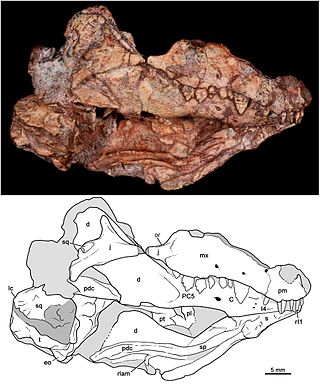
Bonacynodon is an extinct genus of cynodonts that lived in what is now southern Brazil during the Triassic period. The genus is monotypic, containing only the type species Bonacynodon schultzi. B. schultzi is known from two specimens, consisting of two partial skulls and some badly preserved parts of the postcranium. Both specimens were recovered from the Pinheiros-Chiniquá Sequence, part of the Santa Maria Supersequence of the Paraná Basin. This sequence preserves a faunal association known as the Dinodontosaurus Assemblage Zone, which contains numerous other species of cynodonts, dicynodonts and reptiles. Bonacynodon was a small, likely insectivorous cynodont, whose length has been estimated at around 30 centimetres (12 in). It can be distinguished from other cynodonts by its large, serrated (saw-like) canine teeth. Together with the genus Probainognathus of Argentina, it made up the family Probainognathidae, one of the earliest-diverging lineages of the clade Probainognathia. It was a fairly close relative of mammals, the only group of cynodonts alive today.
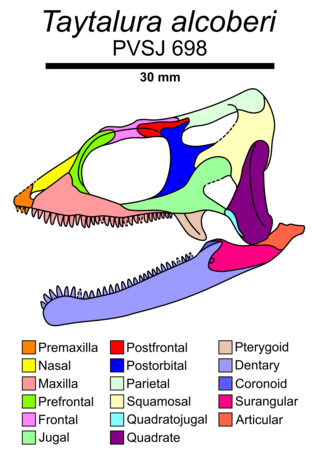
Taytalura is an extinct genus of lepidosauromorph reptile from the Late Triassic of Argentina. It contains a single species, Taytalura alcoberi, which is based on a well-preserved skull from the fossiliferous Ischigualasto Formation. As a lepidosauromorph, Taytalura is a distant relative of modern lepidosaurs such as sphenodontians and squamates. Taytalura did not belong to any group of modern lepidosaurs, since it bears unique features, such as unfused bones in the skull roof and teeth which all sit loosely in a deep groove without sockets. Regardless, Micro-CT scanning reveals features of the skull previously only seen in rhynchocephalians. This suggests that the ancestral condition of the skull in lepidosaurs was more similar to sphenodonts than to squamates.
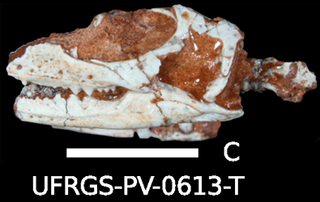
Microsphenodon is an extinct genus of sphenodontian from the Late Triassic of Brazil. The type species is Microsphenodon bonapartei. It is a small sphenodontian with a skull roughly 20 mm long, and represents a unique mosaic of characteristics shared by both early diverging sphenodontians and eusphenodontian characters. Specimens of this taxon were first identified by Bonaparte and Sues (2006) but were misidentified as juvenile Clevosaurus brasiliensis, characteristics such as differences in the configuration of the teeth on the palate, and the unique form of tooth implantation seen in C. brasiliensis, helped differentiate these two co-occurring sphenodontian taxa.

Santacruzgnathus is an extinct genus of small cynodonts from the Late Triassic (Carnian) Santacruzodon Assemblage Zone of Brazil. It contains one species, S. abdalai. Santacruzgnathus is known from a single partial lower jaw with four postcanine teeth, only one of which is well-preserved. Some features of the specimen, including the slender shape of the jaw and the incipiently double-rooted teeth, indicate that the animal was an early member of Prozostrodontia, a group that includes mammals and their close relatives.















